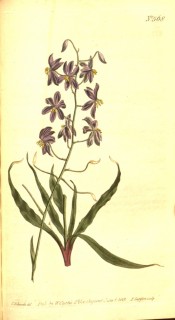Cyanella hyacinthoides L.
Cormous perennial with up to 8 basal leaves, to 30cm long, with wavy margins, and branched flower stems each with up to 10, lightly fragrant, pale lilac or blue-lilac flowers, rarely white, often with a carmine blotch at the base. To 40cm. [RHSD, CECB].
Horticultural & Botanical History
‘It has a small bulbous root, a little like a crocus, which is sometimes roasted and eaten by the Hottentots.’ [LBC no.732/1823]. Introduced to Britain in 1768 [JD], although both Andrews Botanical Repository and Curtis’s Botanical Magazine speculate that the plant described by Miller at this time was not the true Cyanella capensis, this being introduced a little later. [ABR pl.141/1801]. ‘This is a native of the Cape of Good Hope, growing spontaneously at the foot of the Table Mountain. The conical bulbs about the size of those of Crocus verna are said to be edible when roasted. [BM t.568/1802].
History at Camden Park
Cyanella capensis was only listed in the 1845 and 1850 catalogues. It was presumably lost, although it seems to thrive in the Camden area in a pot with no special attention required and offsets and seeds readily. This species is naturalised in Western Australia.
Notes
Published Jan 16, 2009 - 03:14 PM | Last updated Jul 31, 2010 - 04:51 PM
| Family | Tecophilaeaceae |
|---|---|
| Category | |
| Region of origin | South Africa |
| Synonyms |
|
| Common Name | Cyanella capensis L. |
| Name in the Camden Park Record | Cyanella capensis |
| Confidence level | high |
